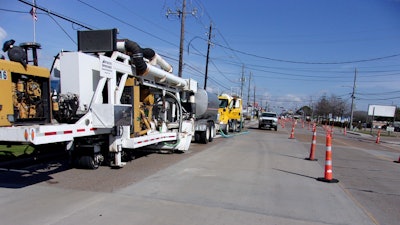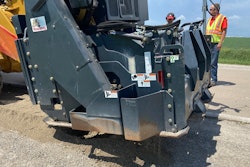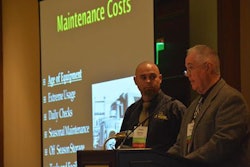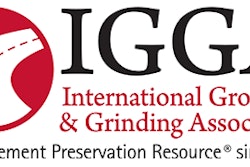
Concrete roads are durable and long-lasting, requiring only targeted rehabilitation and diamond grinding every 25 years or so. With repairs on concrete roads being performed infrequently, however, cities may face a learning curve when it comes to understanding the available repair tools.
When the City of Baytown, Texas, faced ride quality issues on its N. Main Street in 2015, the Public Works and Engineering Department needed to find a cost-effective repair strategy that would perform well considering the unique properties of the street’s pavement. By working with educational institutions and industry experts, the department identified challenges and came up with a solution that resulted in a project that was dramatically lower in cost—by 80%—than initial estimates.
N. Main Street is a concrete road that was installed in the 1980s. It serves as a major right-of-way in the Houston-area City of Baytown, with two lanes in each direction as well as a turn lane. It is also a truck route that serves nearby industrial areas. The aggregate used in the original construction was river rock, an exceptionally hard material. Measurements from hardness tests on the N. Main Street aggregates were an 8 on the Mohs scale of mineral hardness (diamonds measure a 10). Some of the ride quality issues that had developed on the roadway were due to the wearing away of the cement paste layer and consequent exposure of the rock.
On the section of street in need of repair, located between Baker Road to the north and State Highway 146 to the south, pavement condition index (PCI) measurements averaged 43, with four sections being in the low 20s to mid-30s. The PCI scale is based on a 100-point range, with 0 representing the worst conditions and 100 representing the best.
Reconstruction was considered, but with an estimated cost of $12-13 million, the city didn’t have adequate funding for a project of that scope. Through word of mouth, the Public Works and Engineering Department learned that concrete pavement preservation (CPP) was an option.
What is Concrete Pavement Preservation?
Unlike overlays, CPP fixes underlying sources of pavement distress. It consists of targeted treatments such as full- or partial-depth panel replacement, dowel bar retrofit, cross-stitching, crack repairs, and more. By addressing problems at their source, CPP prevents ongoing deterioration, reducing the need for more costly repairs in the future. Pavement condition after CPP is close to or better than that of the original.
Meeting With Experts
Because the City of Baytown had no experience with a CPP program, one of the first steps was to meet with experts to learn more. The Public Works and Engineering Department consulted with states who had experience with CPP, including Minnesota and Kansas. The Public Works team took online training classes through Iowa State University, whose National Concrete Pavement Technology Center (CP Tech Center) offers courses delivered via webinar, video and other channels. The department also worked with the International Grooving & Grinding Association (IGGA), a trade association that serves as a technical resource for pavement preservation and restoration.
The relationships the department formed were maintained throughout the N. Main Street project and guided the CPP process from its earliest phases through to project completion. During project planning, IGGA experts and Baytown officials conducted an in-person inspection of the roadway, confirming that the pavement showed adequate structural integrity and was a good candidate for CPP. They then worked together to develop specifications, gleaning insights from the states with detailed specifications already in place, and collaborated during the contractor search and bidding processes. When Interstate Improvement (a highway contractor based in Faribault, Minnesota who performs work nationwide) was selected to perform the CPP, that company also became involved at an early stage, with project manager Nathan Sirek visiting the city and consulting with department officials prior to the start of work. Together with Interstate Improvement and with the IGGA, the city identified the proper repair procedures for individual distressed areas.
 Full-depth repairs of the concrete road.Courtesy Kevin Harvill, City of Baytown, TX
Full-depth repairs of the concrete road.Courtesy Kevin Harvill, City of Baytown, TX
The Work Done
Construction began in 2020 and was completed in Spring 2021. The City of Baytown replaced approximately 20% of the road surface on the N. Main Street section, with work including:
- Full-depth panel replacement
- Approximately 47,000 sq. yds. of diamond grinding, at 1/8 to 1/4 in.
- Dowel-bar retrofit (using 300 dowel bars) for transverse cracks
- Cross-stitching (using 2,500 deformed rebars) for longitudinal cracks and joints
- Replacement and resetting of manholes
- Crack repair and sealing
The project was a success by all measures. Cost savings were enormous, with CPP treatments being completed for $2.2 million—less than 20% of the cost of reconstruction—saving the city approximately $10 million. PCI measurements improved to an average of 75-80. Not only were department officials pleased with the rideability of the finished road surface, but residents were as well.
 A photo of one of the manholes reset followed by diamond grinding.Courtesy Kevin Harvill, City of Baytown, TX
A photo of one of the manholes reset followed by diamond grinding.Courtesy Kevin Harvill, City of Baytown, TX
Project scheduling is also critical to success. For example, dowel bar retrofit should begin at least a week before grinding is scheduled but it’s equally important to have grinding work completed in a timely manner, to maintain good ride quality for the driving public.
CPP provides a cost-effective repair option for concrete streets while returning the pavement surface to a like-new condition and improving ride quality for the driving public. It keeps existing roads in good structural condition and ensures continued durability for decades to come. For cities looking to stretch their budgets, achieve sustainability benchmarks, and have high-quality roads, CPP is a wise approach.
About the author
Kevin Harvill is the Assistant Director for the Public Works and Engineering Department of the City of Baytown, Texas.


















